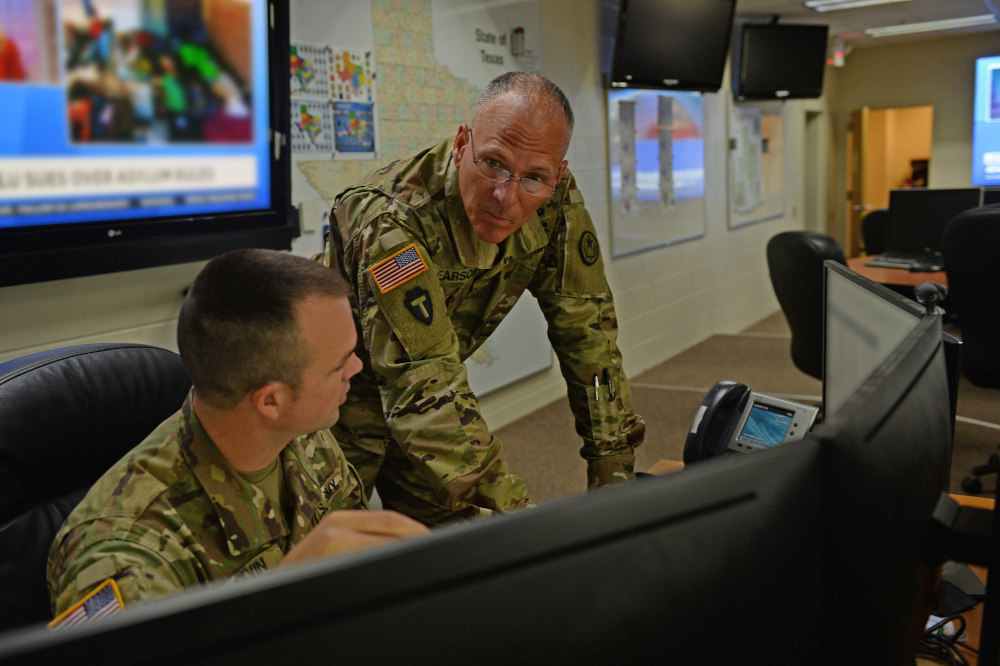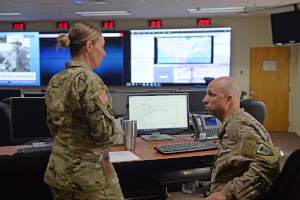Story and Photos By: Caitlin Rourk, Texas Military Department Public Affairs
 Sgt. Kory Colvin, left, and Maj. John Pearson, right, monitor real-time updates in the Texas Military Department Joint Operations Center, Camp Mabry, Austin, Texas. The JOC serves as a link between partner agencies and Texas' 24,000 Guardsmen and civilians.
Sgt. Kory Colvin, left, and Maj. John Pearson, right, monitor real-time updates in the Texas Military Department Joint Operations Center, Camp Mabry, Austin, Texas. The JOC serves as a link between partner agencies and Texas' 24,000 Guardsmen and civilians.
AUSTIN, Texas - Managing information flow for a part-time force, operating in an environment where incidents often occur with no advance warning, requires round the-clock monitoring and coordination. For the Texas Military Department, which has more than 24,000 service members and civilians in its ranks, dozens of agency partners and a dual federal and state mission, its Joint Operations Center plays that critical role.
The JOC is the hub of information flow during both steady state operations, where it oversees the daily battle rhythm of the nation’s largest state military organization, and major incidents to which the Texas Military Department responds, be it tropical or winter weather, floods, wildfires and other civil support and law enforcement operations.
“We are able to communicate with all the major commands and units. We should be able to very clearly tell anyone who walks in—most notably, the Texas Adjutant General—what is available,” Staff Sgt. Kimberly Eastburn, a JOC battle NCO, said. “If the TAG wants to send out a certain number of aviation assets, we know exactly where those are and what is possible since we get those fed to us. The JOC has all the information to handle anything the state needs.”
The JOC has four key charges. First, it ensures timely and accurate communications with TMD components, the National Guard Bureau and interagency partners. Second, the JOC maintains situational awareness, which aids leaders in decision-making, alerts leaders to take action and assists in appraising the effectiveness and efficiency of operations and activities. Third, the JOC provides mission command to TMD forces that are mobilized in support of Domestic Support of Civil Authorities. Finally, it maintains historical documentation.
Located at the Joint Force Headquarters building at Camp Mabry in Austin, Texas, the JOC’s design maximizes accessibility of information and serves as a central collaborative gathering place for TMD personnel and interagency partners during incident responses. Large television screens stream cable news network feeds, screens project real-time numbers and information and Soldiers sit behind computer monitors and phones, acting as a switchboard to units in the field.
In July, TMD renamed the JOC for Sgt. Maj. Elwood H. Imken, a longtime figure in the agency who passed away in 2018. Imken was instrumental in creating TMD’s JOC, and TMD leaders recognized how fitting the dedication would be. Eastburn says she immediately saw the parallels between the JOC and Sgt. Maj. Imken, as both were—in their own unique ways—at the heart of the agency.
“The JOC is the hub of what’s happening in the Texas Military Department. Sgt. Maj. Imken was the hub of almost everything that was happening at Camp Mabry at one time or another in any capacity he served,” Eastburn said.
 Staff Sgt. Kimberly Eastburn, left, and Sgt. 1st Class Clinton Staha, right, discuss a potential unit mobilization in response to flooding at the Texas Military Department Joint Operations Center at Camp Mabry in Austin, Texas.
Staff Sgt. Kimberly Eastburn, left, and Sgt. 1st Class Clinton Staha, right, discuss a potential unit mobilization in response to flooding at the Texas Military Department Joint Operations Center at Camp Mabry in Austin, Texas.
Like most Texas Guardsmen, Hurricane Harvey was the biggest mission of which Eastburn has ever been a part. She says working in the JOC when the governor mobilized the full Texas National Guard gave her greater appreciation for what an unprecedented undertaking it was and how much coordination was involved to accomplish it.
“The coordination and ability to respond and make that happen when it did is because the JOC is so heavily involved. We have the information, from what the State Operations Center needs, to what the Department of Public Safety needs,” said Eastburn. “Our partners know us, and we are the intermediary when a State of Texas Assistance Request, or STAR, goes out. We push the STAR and call out for mission-ready packages, and we know exactly how much it will cost because of all the past experience and events of what’s happened here.”
Capt. Jacob Schreyer, a JOC battle captain, explains that the JOC maintains an especially close relationship with full-time staff at units. Once the JOC receives the STAR, which allows Texas municipalities to request resources from TMD and other agencies for disaster and civil support responses, Schreyer and his team immediately make contact with units well before they are activated. The JOC explains the mission and helps leaders marshal their rosters, something that can be challenging for M-Day leaders who simply cannot be fully engaged on day-to-day unit operations.
Facing the constraints of a largely part-time force, Eastburn says the JOC’s role in supporting readiness and ensuring accurate and timely information flow cannot be understated.
“As far as readiness, we know what we’ve got. We know where the people are. Overall readiness, without the JOC, it would be really hard,” Eastburn said. “We are the communication hub for everything the TAG wants, everything NGB wants, all the way down to the units. Without that, we just have so many different ways the information would flow down and potentially be miscommunicated.”
Battle captains and NCOs man the JOC every day of the year. While the JOC has set core hours, someone on staff is always on-call. More substantial incidents can prompt leaders to initiate the Adaptive Battle Staff, a construct that scales a staff size when responding to a natural or manmade disaster. The ABS has full-time personnel and traditional Guardsmen who come in on State Active Duty orders and different levels that dictate the number of SAD personnel and types of shifts and hours, ranging from Level IV, normal conditions, to Level I, maximum readiness.
“We are postured and ready to turn to 24-hour coverage, with 12-hour shifts and daily shift change briefs, if the agency is in an event response that requires increased manning,” Schreyer said. “We can flip back at a moment’s notice.”
In the months ahead, the JOC will modify how it displays information to maximize impact. Schreyer adds that the JOC is also working toward even greater integration with all three TMD components, including implementing a new system that better synchronizes with the Texas Air National Guard and having liaison officers more regularly present at the JOC.
This article originally appeared in the October 2019 edition of The Dispatch on page 6.